
Colugos are arboreal gliding mammals that are native to Southeast Asia. Their closest evolutionary relatives are primates. There are just two living species of colugos: the Sunda flying lemur and the Philippine flying lemur. These two species make up the entire family Cynocephalidae and order Dermoptera.

Coleonyx is a genus of terrestrial geckos commonly referred to as banded geckos. Species of Coleonyx are found in the southwestern United States, Mexico, and Central America. Most banded Geckos enjoy dry, warm weather which is why they are typically found in the Peninsular Desert. Some, however, prefer humid forests. They are relatively small lizards, measuring about 5–6 in (13–15 cm) inches in total length. They are nocturnal and are found primarily in dry, rocky habitats. Banded Geckos have preyed by snakes, their main predators being rattlesnakes and glossy snakes. Banded Geckos can decipher how they should react when they obtain a chemical cue based on their knowledge of the predator. A main resource they use to distract the predator is losing their tail or escaping quickly. Banded Geckos possess heteromorphic euchromatic sex chromosomes which play a large role in their historical contingency.

Lumbriculus variegatus, also known as the blackworm or California blackworm or Australian Blackworm, is a species of worm inhabiting North America Europe and Australia. It lives in shallow-water marshes, ponds, and swamps, feeding on microorganisms and organic material. The maximum length of a specimen is 10 cm (4 in). Worms raised in laboratory environment are slightly shorter, with 4 to 6 cm long bodies. An adult individual has approximately 150 to 250 1.5 mm wide segments, each of which has the ability to regenerate into a new individual when separated from the rest of the animal. In most populations, this is the primary mode of reproduction, and mature individuals are exceedingly rare; in large areas mature individuals have never been found. The name blackworm is given to at least three distinct species of worm that are identical in appearance and were once considered a single species.
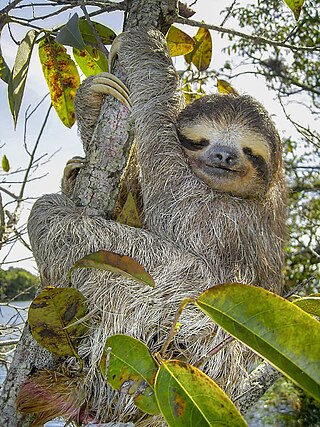
The brown-throated sloth is a species of three-toed sloth found in the Neotropical realm of Central and South America.
Spawning triggers are environmental cues that cause marine animals to breed. Most commonly they involve sudden changes in the environment, such as changes in temperature, salinity, and/or the abundance of food. Catfish of the genus Corydoras, for example, spawn immediately after heavy rain, the specific cues being an increase in water level and a decrease in temperature. When water levels rise, it allows many fish access to areas further upstream, that are better suited for reproduction, that were not previously accessible. This can be a dangerous strategy, as if they wait too long, they may get trapped in small pockets of water, and die when the levels recede.Discus will breed when the temperature goes up and there is an overabundance of food such as mosquito larvae. Many fish stock up on energy reserves to ensure they make it through this exhausting period that is very hard on their bodies, while others go without eating during the spawning process because they are so focused on their offspring.
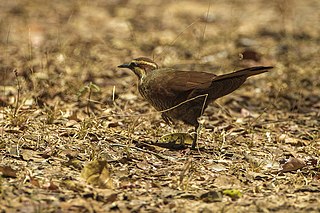
The white-breasted mesite is a ground-dwelling bird endemic to Madagascar. One of three species in the mesite family, Mesitornithidae, it is classified as vulnerable by the International Union for Conservation of Nature (IUCN). It has a small population and is restricted to five sites in the north and west of the island, and one in the east.
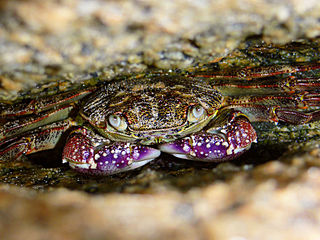
Leptograpsus variegatus, known as the purple rock crab, is a marine large-eyed crab of the family Grapsidae, found in southern subtropical Indo-Pacific Oceans. It grows to around 50 millimetres (2.0 in) shell width. It is the only species in the genus Leptograpsus.

The Sunda flying lemur, also called Malayan flying lemur and Malayan colugo is the sole colugo species of the genus Galeopterus. It is native to Southeast Asia from southern Myanmar, Thailand, southern Vietnam, Malaysia to Singapore and Indonesia and listed as Least Concern on the IUCN Red List. Although it is called "flying lemur", it cannot fly but glides among trees and is strictly arboreal. It is active at night, and feeds on soft plant parts such as young leaves, shoots, flowers, and fruits. It is a forest-dependent species.

Cyprinodon is a genus of pupfishes found in waters that range from fresh to hypersaline. The genus is primarily found in Mexico, the Caribbean Islands and southern United States, but C. variegatus occurs as far north as Massachusetts and along the entire Gulf of Mexico coastline, and C. dearborni and C. variegatus are found in northern South America. Many species have tiny ranges and are highly threatened, in some cases already extinct. Cyprinodon are small; the largest reaches 10 cm (3.9 in) in length and most other species only reach about half that size.

The variegated lizardfish is a lizardfish of the family Synodontidae found in the western Pacific and Indian Oceans, at depths from 4 to 90 m. It can reach a maximum length of 40 cm.

The sheepshead minnow, also known as sheepshead pupfish, is a species of ray-finned fish in the family Cyprinodontidae, the pupfishes. It is found in salt marsh and estuary environments and is native to the eastern coasts of North and Central America.
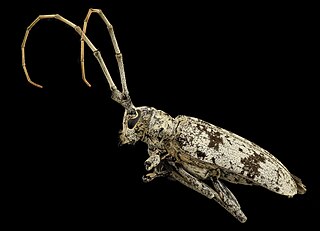
Goes is a genus of longhorn beetles, containing the following species:

The southern torrent salamander is a member of the salamander family Rhyacotritonidae. This species of torrent salamander is found the farthest south in the Pacific Northwest region. It is a small salamander endemic to the region from Northern California to Northern Oregon. It is one of four species of Rhyacotriton, along with R. cascadae, R. kezeri and R. olympicus. All species of Rhyacotriton are small, with their body lengths being less than 5 inches. The species reproduces annually, with an extended courtship and egg-laying period. The time it takes from oviposition to reach sexual maturity ranges from five to eight years, making the generation interval rather long. The larval stage, from hatching to metamorphosis, lasts 2.0-2.5 yr, with females requiring another 1.5–2.0 yr until they can first breed. They reach sexual maturity 1.0-1.5 yr after metamorphosis which occurs between 4.5 and 5.0 yr. This species feeds on small insects and spiders. Although it is found over a large area, it is not a migratory creature. It is preyed on by Pacific giant salamanders and garter snakes.
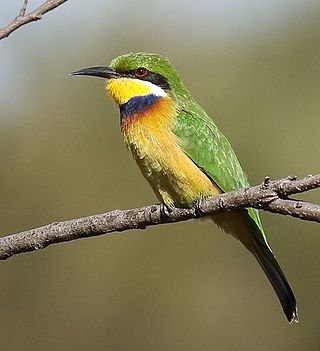
The blue-breasted bee-eater is a central African species of bird. It is a member of the family Meropidae. Meropids are all visually similar and have a diet specialized in Hymenopterans.

The scaly-throated honeyguide is a species of bird in the family Indicatoridae. They have a mutualistic relationship with humans in which they attract beekeepers towards bees' nests and then feeding on the remains, especially larvae.

The rock squirrel is a species of rodent in the family Sciuridae. It is native to Mexico and the Southwestern United States, including southern Nevada, Utah, Colorado, Arizona, New Mexico, West Texas, and the panhandle of Oklahoma.
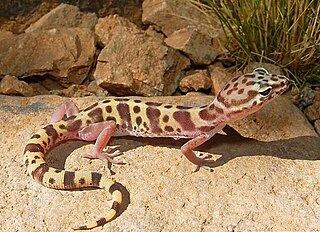
The western banded gecko is a species of lizard in the family Eublepharidae. The species is native to the southwestern United States and adjacent northwestern Mexico. Five subspecies are recognized.

Lytechinus variegatus, commonly called the green sea urchin or the variegated sea urchin, is a species of sea urchin that can be found in the warm waters of the western Atlantic Ocean and Caribbean Sea.

Lithobius variegatus is a species of centipede found in Europe, sometimes called the common banded centipede or banded centipede.

Zonocerus variegatus, the painted grasshopper or variegated grasshopper, is a species of insect belonging to the family Pyrgomorphidae. It is native to tropical Africa, and is considered a crop pest in much of Western and Central Africa.


















